We occasionally link to goods offered by vendors to help the reader find relevant products. Some of these may be affiliate based, meaning we earn small commissions (at no additional cost to you) if items are purchased. Here is more about what we do.
A sharp chef’s knife is THE most important tool in a cook’s arsenal – whether you are a home chef or a pro. Your knife is an extension of your arm, and most importantly, an extension of your brain used to make the art of food come alive on your loved ones’ plates.

However, one of the most important pieces of kit that makes your blade functional, and that is generally the most overlooked, is the humble butcher block.
Many folks choose a cutting board based purely on an emotional response, either to misplaced concerns for sanitation, or to the appearance of the board and how well it matches their existing décor.
But there are some serious concerns regarding ergonomics that you need to consider in the selection process. More importantly, you need to consider how well a cutting board treats your most important cooking tools – your set of kitchen knives.
Why Is a Cutting Board That Important?
A butcher block, also called a chopping block (a misnomer), is designed to allow your food to rest against something solid while you use your blade to cleanly slice through the material.
Although there are convenient electric-powered knife sharpeners available on the market, you should always look to slice into materials that won’t dull your blades to begin with.
A properly designed board should minimize wear and tear on the edges of your knife – a dull blade is a dangerous tool, as it creates a condition where the edge pauses mid-slice, and then as more pressure is exerted, the force overcomes the resistance and allows the edge to snap free in an uncontrolled motion.
This condition sometimes leads to accidents.
Moreover, some cutting boards use a material that is designed for looks or low cost, as opposed keeping your knives’ edges in tip-top condition.
We’ll sort through these construction options and help you to select the best varieties that fit your needs and budget.
Construction Matters – Stone vs. Plastic vs. Wood vs. Bamboo Cutting Boards
Marble/Granite/Stone/Glass
Why? Just why? Why would anyone be willing to sacrifice their set of sharp knives by cutting into a STONE? It’s a STONE. Folks, these were designed to roll pastries out on (the stone is cooler, and thus less sticking happens), not to cut on!
Marble or glass also make excellent materials to set pans on to keep them from scorching a countertop, but do you really want to use a chunk as a cutting board? Ever?
Not so much. Plus, stone is heavy.
 Please, don’t! I cringe just looking at this photo. Like fingernails down a chalkboard…
Please, don’t! I cringe just looking at this photo. Like fingernails down a chalkboard…
That being said, I’m the type that dies a little bit inside every time I witness my sister-in-law cutting something up on a plate with a “good” knife.
Glass/Stone Pros & Cons
| Advantages | Disadvantages |
|---|---|
| Can be used as a hot pad/trivet. | Hardest material that absolutely destroys knife edges. |
| Stone models are very attractive. | Non-renewable resource - uses lots of energy to extract from the earth. |
| No chance of warping. | Made for rolling dough - not slicing. |
| Expensive. |
Bamboo
Although it is very popular as an alternative to wooden cutting boards, and is very green since it rapidly replenishes itself (it’s actually a grass – not a tree), I can’t really recommend a product made with bamboo.
This is a very hard material that can cause the edge of your knife to literally “fold over” in the case of cheaper, softer steels. And due to the high silica (basically sand) content, it can rapidly dull even the harder alloys.
Besides the hardness of the bamboo itself, the loads of glue that manufacturers use to construct these boards will murder your blades’ edges, and rapidly dull even the hardest Japanese kitchen knife.
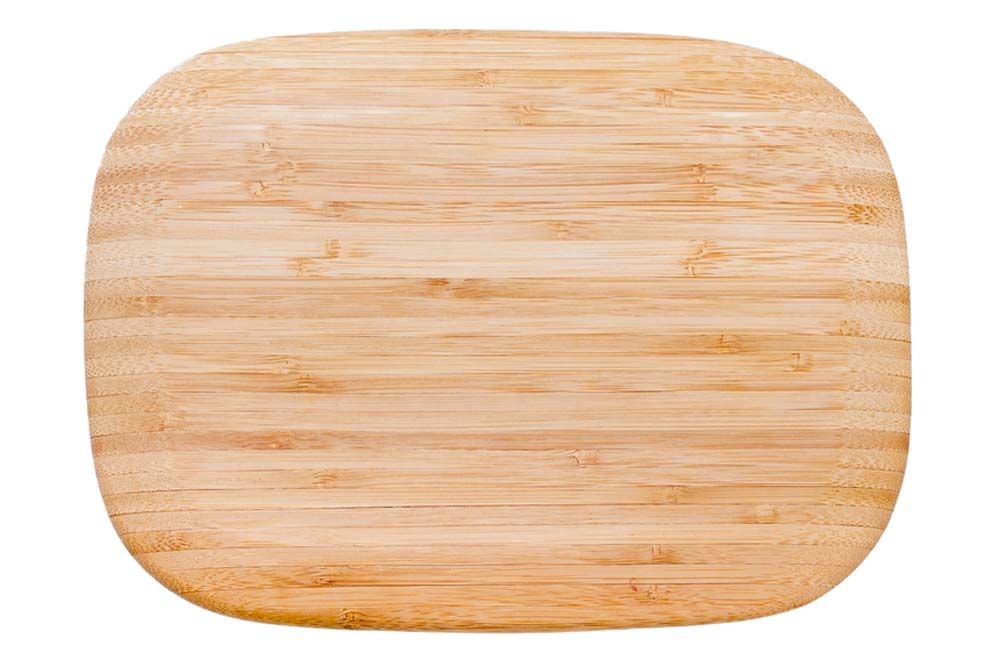 Makes a great serving tray. As far as a butcher block goes? Not so much.
Makes a great serving tray. As far as a butcher block goes? Not so much.
However, bamboo cutting boards can make excellent serving and cheese trays. And by all means, these could be used to cut bread or cheese on. Or, perhaps in cases where having (and keeping) a sharp knife is not all that important (i.e. not for kitchen food prep).
Extra-Large Bamboo Cutting Board available on Amazon
Bamboo Pros & Cons
| Advantages | Disadvantages |
|---|---|
| Renewable resource - fast growing and sustainable. | Dense material, high silica content, and glue not good on knife edges. |
| Not too terribly expensive. | Can't be used as a hot plate. |
| Most models have organic look and feel. | |
| Small chance of warping due to laminated strips. |
Composite
Composite boards are made of variety of substances, like recycled and compressed cardboard, paper, and sustainably harvested wood fiber, and include those made in the USA by the Epicurean Co.
The quality and usability of these vary from very good for the thicker, heavier ones to not so good for the thinner, lighter versions.
Epicurean Nonslip Cutting Board, 14.5-by-11.25 inches, available on Sur La Table
I’m not convinced that the heavier, NSF-approved wood fiber versions are any better for your knives than glass – the ones I’ve used offer up a loud clacking noise similar to cutting on a plate when they’re in use, and I suspect the resins binding the fibers together are very hard.
The lighter cardboard/paper examples tend to be flimsy, and they’re too light to stay in place without significant workarounds. There have been some flaking issues with these in the past, and reports of lingering off-odors with most of the products as well – some report that this issue starts as soon as you open the package and persists with use, while others say the smell goes away after washing.
I suspect the flaking and odor issues vary between batches and I’ve not seen a report of either of these problems in the last several years, which leads me to believe that Epicurean may have fixed some of their manufacturing issues.
I’ll be reviewing some of the more commonly available products – stay tuned!
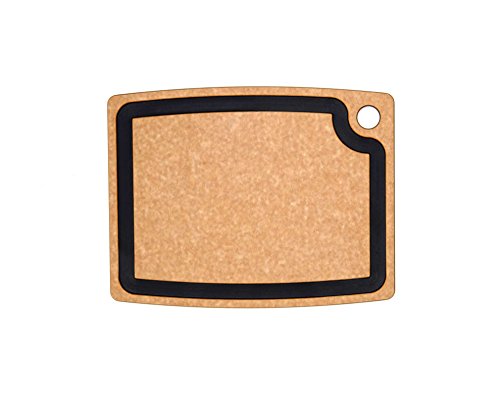
Epicurean NSF Wood Fiber Based Cutting Board available on Amazon
Composite Pros & Cons
| Advantages | Disadvantages |
|---|---|
| Made from either recycled materials or from sustainable and renewable resources. | Wood based models are very dense. Feels like stone and lots of glue means its not good on knife edges. |
| Some are moderately priced. | Paper and card board based models have a history of flaking. |
| All models can be used as a hot pad. | Thicker, wood based models can be fairly pricey. |
| No chance of warping. |
Plastic
A number of you might opt to go with plastic boards, as this provides many more alternatives in terms of colors and styles. Moreover, plastic usually weighs significantly less than a comparably sized wooden board. However, plastic boards tend to discolor, and they have a propensity to stain.
Moreover, plastic chopping boards tend to be a little harder on your kitchen knives than other materials. Not enough for me to advise you against purchasing one or two, but this is something that you should take into account before making them your primary boards.
Unless you need a product that can serve double duty as a hot plate, I would definitely go with plastic long before I’d choose composite. Many people keep one or two around exclusively for slicing up raw proteins.
Enviroboard 100% Microwaveable Sterilization Antibacterial Cutting Board Set
When you slice against these boards while chopping up your food, you are making grooves in the plastic, which allow liquids to permeate and discolor the surface. Moreover, these grooves can harbor bacteria.
Not long ago, I tossed out a number of my older plastic chopping boards, as they were appearing a little bit tattered despite a good overnight soaking in bleach.
However, I have been eyeballing the Enviroboard set pictured above as it looks like it does a pretty good job of allowing complete removal of bacteria. And the three colors allow you to quickly identify which one you generally use for meat, and which you reserve for veggies, helpful in the effort to prevent cross-contamination.
Plastic Pros & Cons
| Advantages | Disadvantages |
|---|---|
| Can be found made of recycled materials (some models only) | Home models may be too light and thin which encourages slipping and sliding on counters. |
| Good for retaining knife sharpness. | Most models cannot be used as a hot pad. |
| Can be found in heavier commercial models that limit the sliding effect on your work surface. | Standard white versions are a little ugly (subjective), |
| Safe with most cleaning products including bleach. | |
| Can cycled through a dishwasher and safe for extended soak times. |
Rubber
Rubber boards are gaining popularity – particularly in professional restaurants. They are said to offer identical edge retention assistance to wood blocks, as well as possessing comparable self-repairing capabilities.
Based on my own non-scientific assessment, they do tend to degrade the sharpness of my knives a little faster.
By how much? I can’t really say. Perhaps it’s about 1.5x as fast as a comparable wood unit, but I never really measured it, and unfortunately have no way of actually testing this.
However, one of the key benefits of the rubberized construction is the fact that they do not hold germs or wetness. Also, they are able to tolerate most harsh cleaning agents and can handle anything a dishwasher can throw at them – heck, take them to the car wash if you want to!
Rubber cutting boards are very thickly constructed sturdy rubber mats that are quite hefty, and for that reason they will not slide around on your counters.
Sani-Tuff 12 x 18 x 3/4″ Rubber Board found on Amazon
They can be quite pricey and often cost as much as the well-built wooden models, but I’ve found the Sani-Tuff line to be quite reasonable – check out our complete review.
Rubber-based products should be considered a top candidate for a kitchen that deals with a lot of protein, and where you would like to have virtually no chance of staining your boards.
I really like the rubber products, and started to use them exclusively for my protein prepping tasks after I threw out my aforementioned plastic versions.
These are available in a variety of sizes, usually with a 1/2-inch and 1-inch thickness available for any given dimension. I prefer the thicker ones as these products can actually be sanded down and resurfaced, and I like to buy my kitchen equipment for the long haul.
Rubber Pros & Cons
| Advantages | Disadvantages |
|---|---|
| Are all natural and made from renewable resources - rubber trees. | Since they are quite heavy, they may be painful for smaller statured folks to easily move around. |
| Great for keeping your knives edges in tip top shape. | Can't be used as a hot pad as they may melt. |
| Heavy and will not slide around on your counters. | |
| Any kind of household or commercial cleaning product can be used to include bleach. | |
| Safe for extended soaking and for use in dishwashers. | |
| Can be resurfaced - especially the thicker versions. |
Wood
Wooden cutting boards, in my opinion, are about the best that you can find. The idea that they are less hygienic than plastic versions is a fallacy, as a UC Davis study has shown.
Whereas bacteria sit on top of a plastic surface and may find their way into cuts and scratches, and thus may remain hidden and ready to infiltrate your food the next time the surface is in use, a wooden product tends to “suck” the bacteria down into its depths, where they die of dehydration. This is especially true if your board is well cared for.
“If a sharp knife is used to cut into the work surfaces after used plastic or wood has been contaminated with bacteria and cleaned manually, more bacteria are recovered from a used plastic surface than from a used wood surface.” – UC Davis Study

John Boos Reversible End Grain Maple Chopping Block, 20 by 15 by 2.25-Inch
Wooden butcher boards are also very good for your knives’ edges, and allow you to maintain sharpness for the maximum amount of time. Moreover, they offer a visual and tactile appeal that plastic can’t match.
However, there are construction differences between models and makers that you should be aware of, so I’ve also written a separate article on how to select the best wooden cutting board.
Wood Pros & Cons
| Advantages | Disadvantages |
|---|---|
| Are all natural and made from renewable resources - normally North American grown hardwoods. | Strong solutions of bleach cannot be used (although lighter dilutions are generally ok). |
| The very best for keeping a keen edge on your kitchen knives. | Must be keep hydrated with mineral oil and (optionally) bees wax or food grade carnauba. wax. |
| Usually heavy and will not slide around on your counters. | Cannot remain soaked in water for long periods(although running under a faucet for cleaning is ok). |
| Can be easily resurfaced - either with a sander or if no feet are attached they can be quickly ran through a wood planer with very sharp blades. | |
| Most wooden examples are very attractive and lend an organic look to any décor. | |
| Have been shown by multiple university studies to have a lower bacteria load than that of plastic - particularly as the plastic ages and receives more cut marks. | |
| Although very subjective - wooden version have by far the best "feel" when sliced into. |
Ergonomics
Besides the construction material, size and shape also affect how much you’ll enjoy using your cutting boards.
Some folks like to have several different sizes for different tasks, or they utilize one as their “protein only” slicing area in order to keep their main work surface a little more sanitized, to avoid cross-contamination.
However, with proper sanitation methods, you can use the same product for a variety of tasks.
Size
Butcher blocks are available in a variety sizes – from those with 20 to 30 inches of work space that stand on their own legs or base cabinets, to 12- to 20-inch units that sit flat or on small knobs on your work surface, to diminutive examples that are designed for easy transport with one hand.
A smaller “always on the counter” example such as this John Boos 9-Inch model makes a lot of sense for everyday use.
If you prefer the type that sits on your counter, you may want to add your sink size into the equation. Ideally, you should be able to fit about 1/3 to 1/2 of it, in its most skinny orientation, into your sink to allow for easy cleanup and scrubbing.
Size is not a real deal breaker if you would like a larger one – simply clean it in place rather than submerging it in the sink, according to our recommended directions.
Thickness
Again, if you want a more portable board, you may want to consider one that is not as thick, in order to reduce the weight. However, a thicker board will give you a more stable platform – especially if the board sits on feet or knobs – and also allows for future resurfacing, in the case of heirloom quality wooden examples.
As alluded to earlier, thinner versions have the very annoying habit of sliding all over the place, necessitating the use of towels, rubber mats, and other devices in order secure them to your countertop – and this is not ideal.
Catskill Craftsmen 14-Inch Round Slab with Feet
If you’re looking for something a little bigger than the 9-inch example in the last section, I’d recommend the Catskill 14-inch model shown above for everyday countertop use.
It’s small enough (just barely) to fit in the sink, features feet that allow equalization of air flow (helping to prevent cracks and warping), and its uncommon shape adds visual interest to your kitchen’s work space.
Moreover, its thick end grain construction minimizes abuse to your knife edges, and stabilizes the wood.
In the Groove (or Not)
One other thing that you may want to consider when researching which is the best cutting board that will fit your needs is whether or not you would like a juice groove.
These are grooves that run around the perimeter of the surface in order to catch liquids that you might like to reserve, usually after the food has been cooked. These are actually termed “carving boards” but they can be used for slicing raw ingredients as well – for example, they can be nice to use if you’re cutting a juicy pineapple and want to reserve the flavorful liquid that seeps out as you carve.
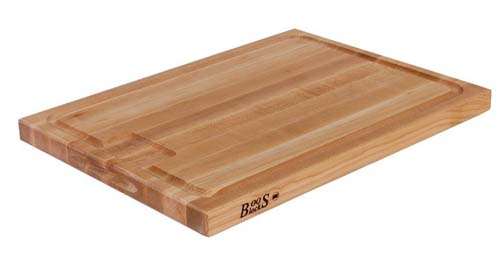
The John Boos Au Jus 18-by-24-Inch Maple Cutting Board features a nice deep groove, perfect for collecting juices.
If you decide you’d like a model with a groove, be sure to get one with a deep well that can collect as much of the liquid as possible. Many of the cheaper products in this category have very shallow cutouts, and their use for this purpose is very limited.
Personally, I don’t use a grooved board for my normal slicing and dicing duties, but I do have a carving board on hand for slicing roasts, hams, and the occasional turkey.
Cutting Board Recommendations
If you’ve made it this far, you’re probably looking for a few more recommendations in order to begin your research. I’ll be reviewing some specific models in upcoming posts.
In the meantime… Cook, Eat, Live Well, and Prosper.
– Lynne
About Lynne Jaques
Lynne is a stay-at-home mother of two boys. As a former US military officer and the spouse of an active duty US military member, Lynne enjoys traveling the world (although not the moving part!) and finding new cuisine and methods of preparing food. She also has the habit of using parenthesis way too much!

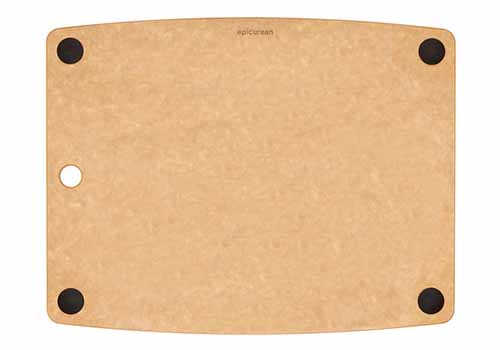

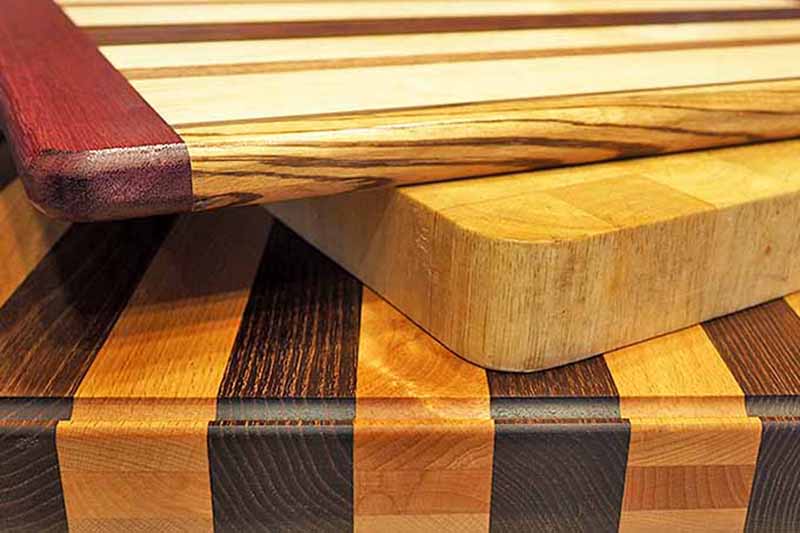
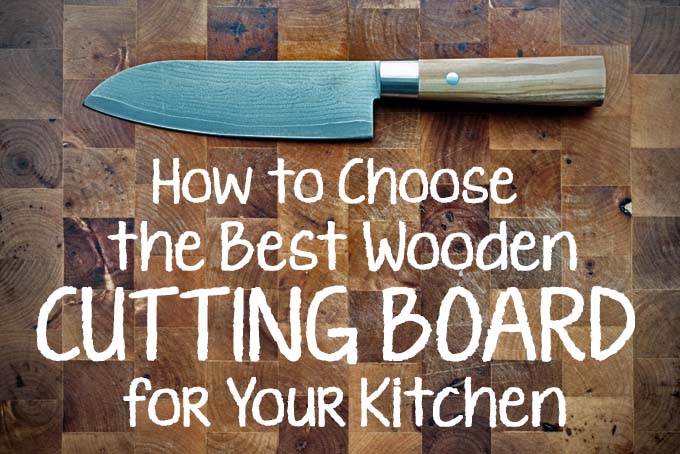
This was very helpful! My mother is in the market for a cutting board. She has a small plastic one but she is wanting a wooden board.
I am glad to be able to advise her that that is a very good choice. As you mentioned, I had heard that the wood can harbor bacteria more than the other types so we were shying away from that kind but now I know we can purchase one with confidence. The look of the wooden boards is so appealing to me as well. I do like how the granite ones look as well but the expense (and weight) have kept those out of the running.
Looking forward to more info on your recommendations!
Ria,
Thanks for the comment. Yes, it surprises many that wood harbors some the least amount of bacteria (according to the cited UCC study and there are university studies out there as well). You can check out my guide to wooden cutting board here:
http://en02-phx.stablehost.com/~lynnesca/gadgets/choose-best-wood-chopping-block-kitchen/
Also, another very good option are natural rubber models with the “go to standard” being the san-tuff brand which we will be reviewing in the very near future.
Cheers
Lynne
I’m always worried about my wooden cutting board harboring nasty things so I make sure to clean it often. I’ll give some of your suggestions a try because I think what mine is made out of will get me into trouble sooner or later. Plus, my current board is cut up pretty bad and it’s about time to replace it before it has too many problems!
Spaceman,
You’ve read my mind (yet again). I plan to write another article really soon about the proper way to clean and disinfect work surfaces and chopping blocks. I’ll post a link here when I’m done, but if you are really interested, you could sign up for our mailing list and get an update as soon as I hit the post button!
Cheers
Lynne
Nice article. Rubber boards are actually synthetic rubber, not real rubber. They should actually preserve your knives better than other cutting boards if proper cutting technique is used. (With a rubber cutting board, the knife should not need to be dragged along the board when it reaches the board.) Finally, they should not be put into the dishwasher, because they will become soft. Thanks for your thorough article though!
I’ve been using a basic plastic cutting board, would you recommend switching to wood?
My cousin’s use a wooden cutting board, just think, cutting onions, coriander, tomatoes, garlic, meat e.t.c no matter how hard one tries to clean that surface, there will be that ‘off’ combination smell lingering on, from that experience, i decided to buy a plastic cutting board, easy to clean, doesn’t harbor that ‘strange’ smell, maybe the downside would be carrot juice, onion, tomato stains…this is where bleach comes in handy…but to know there are other options to consider, am glad to have stumbled on this page…spoilt for choice i say 🙂
This article was very helpful because I usually give a cutting boards and cutlery as gifts during the holidays. Now I will be able to make a more informed decision. Thanks.
This post is very helpful for safekeeping in the kitchen. We have plastic cutting boards at home which are both white and can be very tatty at times. Maybe its better to switch on wooden ones though both may show scratches on the surface, yet its the bacteria that is unsafe, which is more likely exist in plastic boards. I should share to my mom this article!
We have plastic cutting boards at home which are both white and can be very tatty at times. Maybe its better to switch on wooden ones though both may show scratches on the surface, yet its the bacteria that is unsafe, which is more likely exist in plastic boards. I should share to my mom this article! Thanks for this post, it is very helpful for safekeeping in the kitchen.
Do you have a recommendation on how often one should replace plastic cutting boards? It seems that mine got all scratched out and old-looking after a couple of months. I even got the color-coded ones, so I could cut meats, veggies and cut foods separately (though my husband doesn’t grasp the color-coding concept and uses them randomly, which defeats all the purpose)
I bought a Beech wood chopping board a few months back. I have always used wooden boards, and I don’t think I will change. They feel sturdy, they feel right.
The wood is from sustainable forests, and it does the job really well.
It is Beech wood all the way for me!
Wow! This is a pretty interesting article and an eye-opener.
I have several different cutting boards at home, but I have to admit that I have not really put much thought on which one is the best for my knives. I have been pretty partial to my bamboo cutting board although when rushed I prefer to use my lighter plastic ones. Before your article, I didn’t realize that my bamboo board can be too hard on my knives.
Now, I have to take a closer look on my cutting boards. This might be the incentive I need to pull out my heavy wooden board out (stashed somewhere and rarely use due to its bulkiness and weight) or an excuse to go buy a new one, one that is lighter and more manageable.
Thank you for sharing the info. I really appreciate the extensive details and information you have put together in this piece.
I have been using a heavy plastic cutting board now for a while, thinking that it was more hygienic. I had no idea that wasn’t the case after all! Food safety is my number one consideration for my cutting board, since I frequently buy whole chickens and cut them up. I liked the plastic because I could clean it with bleach afterwards, but maybe I need to rethink that after all. It looks like a good wood board can be lightly cleaned with some bleach as well, plus it’s a little safer in the long run. I would have never guessed.
I always thought the giant white plastic cutting board was ugly too.
The people who lived in this house before us cut things up right on the countertops. You can tell because of all the knife scratches. It is so disgusting. I would never want my food to touch the counter. I had one other house where the countertops were made of butcher block. The people that lived there before me cut things right on their countertops as well. I guess they thought that’s what the butcher block countertops were for. It looked awful, and I’m sure it wasn’t healthy either. This must be a common occurrence, I’m guessing. Ugh!
Based on these charts and suggestions I think my next cutting board will be wood. It seems to have the most pros. It has drawbacks but I’m pretty mindful of those anyway. My second choice would be granite because I love how those look. They require a bit more care but I can do that since I spend a lot of time in my kitchen.
Very helpful. I’ve spent way to much money on cutting boards and I REALLY should have done my research beforehand. First I purchased a glass one and the noise when the knife touches it is awful. Now I have a few plastic ones and they are terrible as well. They slide around so much! It’s time to invest in a quality wood one without a doubt.
What a great post to come across I have been trying to help my mom decide on a new cutting board for a while now. She has a bamboo one but we are really wanting to switch to wood for obvious reasons. Your post really helped us in making our decision about what to switch to next!
I’ve color coded mine as I’ve moved to all restaurant grade versions. Red for meat, green for veggies, yellow for poultry, white for everything else and good old fashioned wood for bread. I also have several lite and bendable versions for beans and even grilling out etc. One I keep rolled up in our camping and tailgate items.
Interesting that there is a study about wood cutting boards. My mother-in-law has her restaurant and uses a rubber board, it does quite a good job (and she is quite adapt at knife sharpening, it’s almost scary!). I think I’ve heard of a law somewhere that forbids restaurant from using wood board to cut meat etc. for sanitary purposes. But I get news from so many places sine my friends are all around that I cannot really remember from where 🙁
I have both a plastic, and wood cutting board. I use the wood one for cutting up meats like chicken or beef. I use the plastic one for my veggies. The plastic one has raised edges, and becomes narrow at the end for easy pouring of veggies into a bowl.
I’m a fan of the separate color-coded chopping boards that are available. I took a catering course at college many moons ago and the hygiene habits have stayed with me since. I agree that they don’t look great though and they are certainly not something that I would have on display in my kitchen. Some of the butchers blocks featured in this article look great though and I’m almost tempted to buy one just for decorative purposes only!
I keep a variety of cutting boards on hand, mainly for different purposes. I have a fondness for the wood boards, and now, for the rubber ones, after reading this. I love things that are as natural as possible, while being visually pleasing, but most of all, I appreciate that they are actually better health-wise, since they are safer for food preparation, being anti-bacterial. I’m glad I read this, so I know the wood and rubber boards are easy to clean, and don’t move around as much. I have cut myself in the past, when a board slipped, so I stay away from lightweight boards that tend to move around.
I never thought that people would be willing to cut into stone. That seems like a terrible idea, even though I hate wet wooden cutting boards.
From what you’ve written, I like the rubber ones best – they must dry quickly, and are very easy to use!
This is very helpful, I have recently bought a wooden cutting board because I love they way they look. Now I know this is actually the best option for my knives as well. I was a bit worried about the growth of bacteria, but now I know that it is OK if I clean the board regularly. What would be the best way to keep a wooden cutting board beautiful and safe? What is the best oil treatment to put on? Thanks
I didn’t realize that the material of a cutting board makes such a big difference, especially to the maintenance of sharp knives! I kind of thought the only real distinction was whether or not the surface held bacteria, and like you mentioned, I always believed that wooden boards were the worst for that.
Currently I’ve got bamboo ones, and even though I feel like they have their faults I wouldn’t have thought that dulling my knives is one of them. It looks like once the ones I have wear out, I’m going to hunt down a heavy duty rubber one 🙂
Wow, that picture of the stone surface made my teeth hurt thinking about it. I personally used to use a simple plastic board. You know those cheap ones you get anywhere? A chef friend of mine told me that plastic harbours ALOT of bacteria.. He bought me a gift of a beautiful wooden block and recommended I have several different products and use them specifically for each thing. Meats, vegetables, etc… Plastic board for proteins, and wood for prepping vegetables, etc.
That was last year. For my birthday I got a beautiful ergonomic design by yanko. It was a bit of an overkill.. haha… but I love it!
Thanks for the article. It was very informative and helpful.
There really are a ton of different kinds of cutting boards on the market nowadays, so it definitely helps to know how to choose the right one. I particularly like that the article goes into the benefits of different materials such as bamboo and plastic. After all, you will want a board that is easy on your knife so that it doesn’t get damaged while you’re cutting.
Hi Lynne
What is the advantage of using a wooden cutting board over the plastic board? At present, I am using a plastic board. Thanks
These cutting boards are made up of various substances such as compressed cardboards, recycled papers or harvested wood fiber, etc. They come in thicker and heavier form but are considered as a better choice than glass chopping boards as composite materials are safe for your knives.
I do not understand why wood is still recommended, if the public health standards for all restaurants are prohibited, only stainless steel can be used and teflon, a material other than plastic, is used for cutting boards and friendly with the cutting edge knifes, It is clear that teflon has no pores and wood does not matter how dense wood or bamboo is. It is impossible to guarantee hygiene because bacteria reproduce in the pores.
Using a stone board may affect the sharpness of the knife, so I will recommend a wooden board for the best practice. On wood, vegetables cut fine and I have been using it for years.
Every example of Bamboo shown on this webpage is side grain. Side grain bamboo should never be used as a cutting board, it will not feel right and will dull blades. Just like any side grain hardwood will.
This webpage describes and shows several end grain products, yet the writer fails to discuss the benefits of a well made end grain cutting board. SHAME ON YOU.
If it is for a bread board or cheese board, I don’t care what you buy. If it is for cutting and chopping, meats, fruits, veggies, or anything else, end grain is the ONLY product that is made for the job, feels safe when using and does NOT dull knives quickly.
Bamboo is excellent in end grain as well. I literally chop over 60 pounds of meat with a cleaver each month, through the bone and all on a well made end grain bamboo board.
Please consider that it’s very common for plastic and rubber materials to be loaded with fine particle “fillers” that are used to modify the properties of the material (hardness, stiffness, strength), add color, etc. Many fillers are minerals (silica is an example) that can be harder than knife steel and thus abrasive and likely to dull knives. When considering using a plastic or rubber board with my better knives I’d like to know specifically what’s in them. I doubt most manufactures or these products consider this.